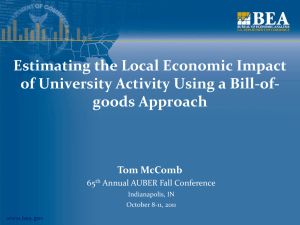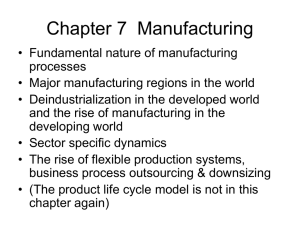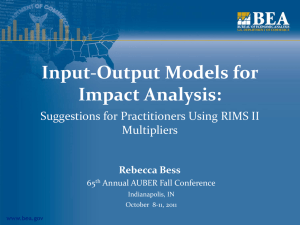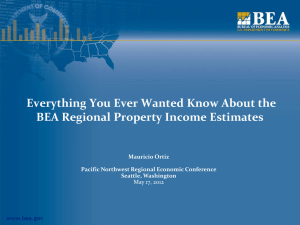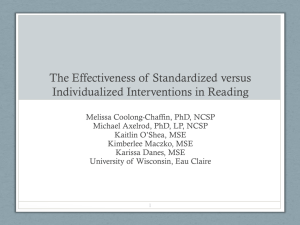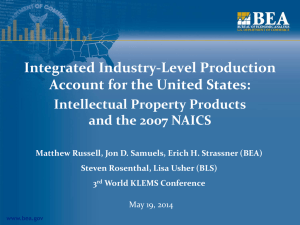Slides - World KLEMS
advertisement
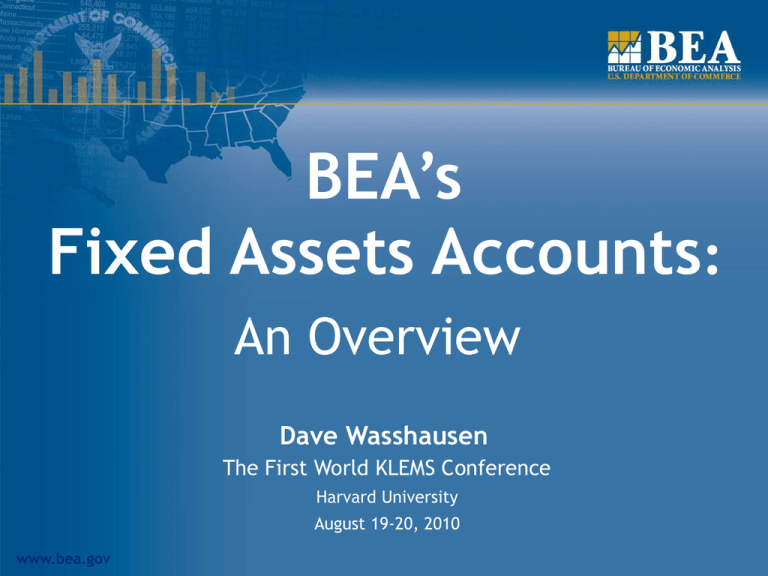
BEA’s Fixed Assets Accounts: An Overview Dave Wasshausen The First World KLEMS Conference Harvard University August 19-20, 2010 www.bea.gov Fixed Assets Accounts (FAAs) ▪ Net [Wealth] Stock ▪ Investment ▪ Depreciation ▪ Other Changes in Volume of Assets (OCVA) ▪ Average Age www.bea.gov 2 Net [Wealth] Stock vs BLS Productive Stock ▪ BEA calculates wealth stocks Depreciation rates generally derived from market prices of used assets Corresponding depreciation reflected in the NIPAs as a charge against income from current production ▪ BLS calculates productive stocks Deterioration rates reflect productive capability of the asset Used to calculate multifactor productivity www.bea.gov 3 Wealth Stock vs Productive Stock ▪ Assets depreciate (BEA) quicker than they deteriorate (BLS) ▪ For example, an automobile provides similar level of productive service after 1-year of use; however its value has declined significantly www.bea.gov 4 Wealth Stock vs Productive Stock Millions of dollars 1000 800 600 400 ` 200 t+ 12 t+ 16 t+ 20 t+ 24 t+ 28 t+ 32 t+ 36 t+ 40 t+ 8 t+ 4 t 0 Year BLS Productive Stock www.bea.gov BEA Wealth Stock 5 Valuations ▪ Historical-cost Book value measure ▪ Real-cost Quantity measure ▪ Current-cost Replacement-cost measure Current-cost depreciation is the featured NIPA depreciation (aka consumption of fixed capital or CFC) www.bea.gov 6 Perpetual Inventory Method (PIM) Used for all asset-types except autos to indirectly derive net stock: Kjt = Kj(t-1)*(1-rj) + Ijt*(1-rj/2) - Ojt Where: Kjt = net stock for year t for type of asset j rj = depreciation rate for type of asset j Ijt = investment for year t for type of asset j Ojt = other changes in volume of assets for year t for type of asset j www.bea.gov 7 Physical Inventory Method ▪ Applies independently estimated prices to a direct count of the number of physical units of each type of asset. ▪ More direct than PIM but is used only for autos because they are the only type of asset with sufficient source data. www.bea.gov 8 Estimating Methodologies ▪ PIM can be rewritten as follows: Kjt = Kj(t-1) + Ijt - Ojt - Mjt Where: Mjt = depreciation for year t for type of asset j ▪ Depreciation is estimated as a residual as follows: Mjt = Ijt – Ojt - (Kjt - Kj(t-1)) www.bea.gov 9 Estimating Methodologies ▪ Historical- and real-cost net stock and depreciation are calculated using the perpetual (or physical) inventory method. ▪ Current-cost net stock and depreciation are calculated by reflating real-cost estimates. Price indexes taken from NIPA fixed investment estimates. Current-cost estimates can be sensitive to price changes (i.e., CFC for housing in recent periods). www.bea.gov 10 Current-cost vs. Historical-cost 120.0 100.0 80.0 60.0 40.0 20.0 0.0 200,000 150,000 100,000 50,000 0 Index level 250,000 19 99 20 00 20 01 20 02 20 03 20 04 20 05 20 06 20 07 20 08 20 09 Millions of dollars Depreciation for Owner-Occupied Housing Current-cost www.bea.gov Historical-cost Price Index 11 Investment ▪ Investment (nominal and real) by asset-type comes from NIPAs for most assets. Handful of asset-types that differ for the FAAs -- private fixed investment reconciliation tables can be found here (www.bea.gov/national/FA2004/index.asp) ▪ Investment by industry and by legal form of organization (LFO) are derived using Census data on: Capital expenditures by industry Payroll and revenue by legal form of organization. www.bea.gov 12 Depreciation ▪ Depreciation profiles are based on empirical evidence of used asset prices in resale markets wherever possible. ▪ Geometric patterns are used for most asset types because they more closely approximate actual profiles of price declines than straight-line patterns. ▪ Based on empirical studies, BEA data, or technological factors, some assets (autos, computers, missiles, and nuclear fuel) justify the use of a nongeometric pattern of depreciation by BEA. www.bea.gov 13 Depreciation ▪ Rates are calculated by dividing the declining-balance rate (DBR) by the asset’s assumed service life. ▪ DBRs primarily derived from estimates made by Hulten and Wykoff under the auspices of the U.S. Department of the Treasury. www.bea.gov 14 Service Lives ▪ Service lives for nonresidential fixed assets based primarily on studies conducted by the Department of the Treasury. ▪ Service lives for most types of residential structures are taken from a study by Goldsmith and Lipsey. www.bea.gov 15 Service Lives ▪ Ideally, service lives would be calculated by industry and varied over time to account for changes in business conditions and technology; however, data limitations prevent this. Service lives for the following assets vary by industry: Communications equipment, metalworking machinery, special industry machinery, general industry machinery, heavy trucks, aircraft and service industry machinery. Service lives for the following assets vary over time: Computers, office and accounting machinery, light and heavy trucks, autos, aircraft, electric power structures, and mining exploration, shafts, and wells for petroleum and natural gas. www.bea.gov 16 Published Depreciation Rates Type of Asset Photocopy and related equipment Rate of Service depreciation life Declining balance rate 0.1800 9 1.6203 Years before 1978 0.2729 8 2.1832 1978 and later years 0.3119 7 2.1832 Other fabricated metal products 0.0917 18 1.65 Steam engines and turbines 0.0516 32 1.65 Internal combustion engines 0.2063 8 1.65 Office and accounting equipment: www.bea.gov 17 OCVA War losses (begin with 1940) Estimated from a variety of sources, including newspapers and other media sources. Disaster losses (begin with 1971) Generally defined as catastrophic events with property losses exceeding 0.1 percent of GDP (or about $15 billion). Also estimated from a variety of sources, including insurance-related trade data, risk management firms, and official government reports. www.bea.gov 18 20 08 20 02 20 04 20 06 19 96 19 98 20 00 120,000 100,000 80,000 60,000 40,000 20,000 0 19 92 19 94 Millions of dollars Disaster Losses Disaster Losses www.bea.gov 19 Average Age ▪ Weighted average of the ages of all depreciated investment in the net stock as of yearend. ▪ Net stock expressed as a function of investment only: Kjt = Ijt*(1-rj/2) + Ijt-1*(1-rj/2)(1-r)1 + … + Ijt-n*(1-rj/2)(1-r)n ▪ Net “age” stock calculated by “aging” each vintage of investment as follows: = (0.5)*Ijt*(1-rj/2) + (1.5)*Ijt-1*(1-rj/2)(1-r)1 + … + (n+.5)Ijt-n*(1-rj/2)(1-r)n ▪ Age equals net “age” stock divided by net stock www.bea.gov 20 Average Age Example Year Ijt Kjt Age_Kjt Age_Kjt derived as a function of investment, Ijt t 5 4.9 2.4 = 0.5 * (5 * 0.975) 0.5 t+1 10 14.4 11.8 = (0.5 * (10 * 0.975)) + (1.5 * (5 * 0.975 * 0.95)) 0.8 t+2 20 33.2 34.6 2 = (0.5 * (20 * 0.975)) + (1.5 * (10 * 0.975 * 0.95)) + (2.5 * (5 * 0.975 * 0.95 )) 1.0 t+3 40 70.5 83.9 2 = (0.5 * (40 * 0.975)) + (1.5 * (20 * 0.975 * 0.95)) + (2.5 * (10 * 0.975 * 0.95 ))… 1.2 Age Where: Ijt = investment Kjt = net stock Age_Kjt = "age" stock Age = Age_Kjt ÷ Kjt * The depreciation rate is assumed to be 0.05 in this example www.bea.gov 21 Published Estimates Standard FAA tables presented by: Asset-type Industry Legal form of organization Detailed FAA Tables presented by: Detailed asset-type and industry www.bea.gov 22 BEA Fixed Assets Accounts www.bea.gov/national/FA2004/Index.asp Email questions to: FANIWD@bea.gov Or David.Wasshausen@bea.gov (202) 606-9752 www.bea.gov 23
